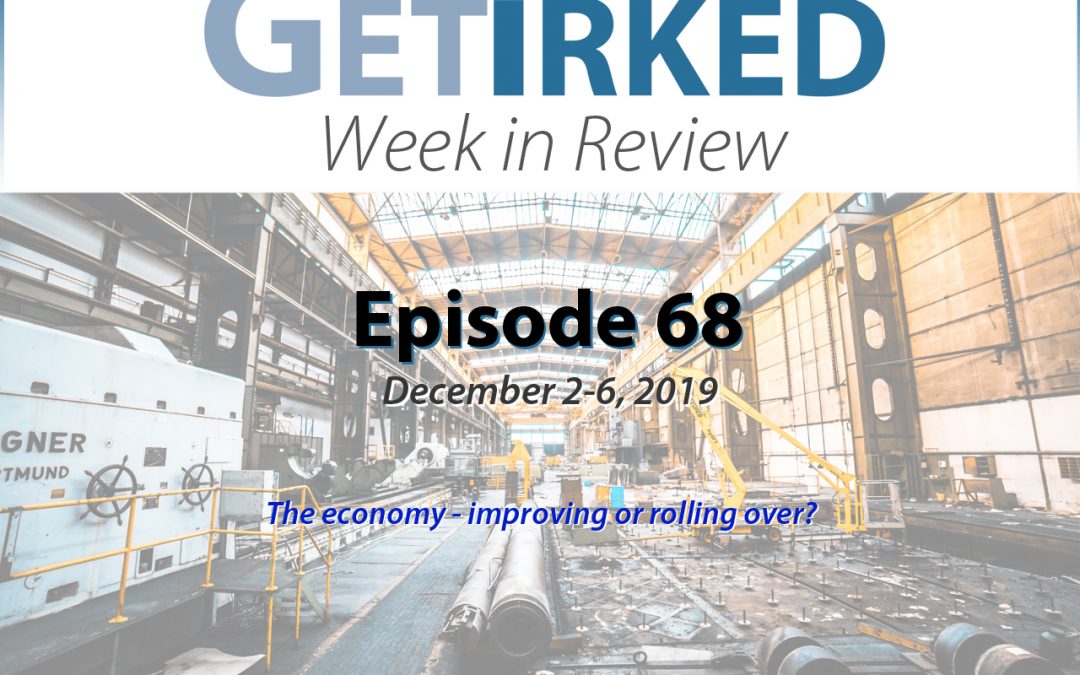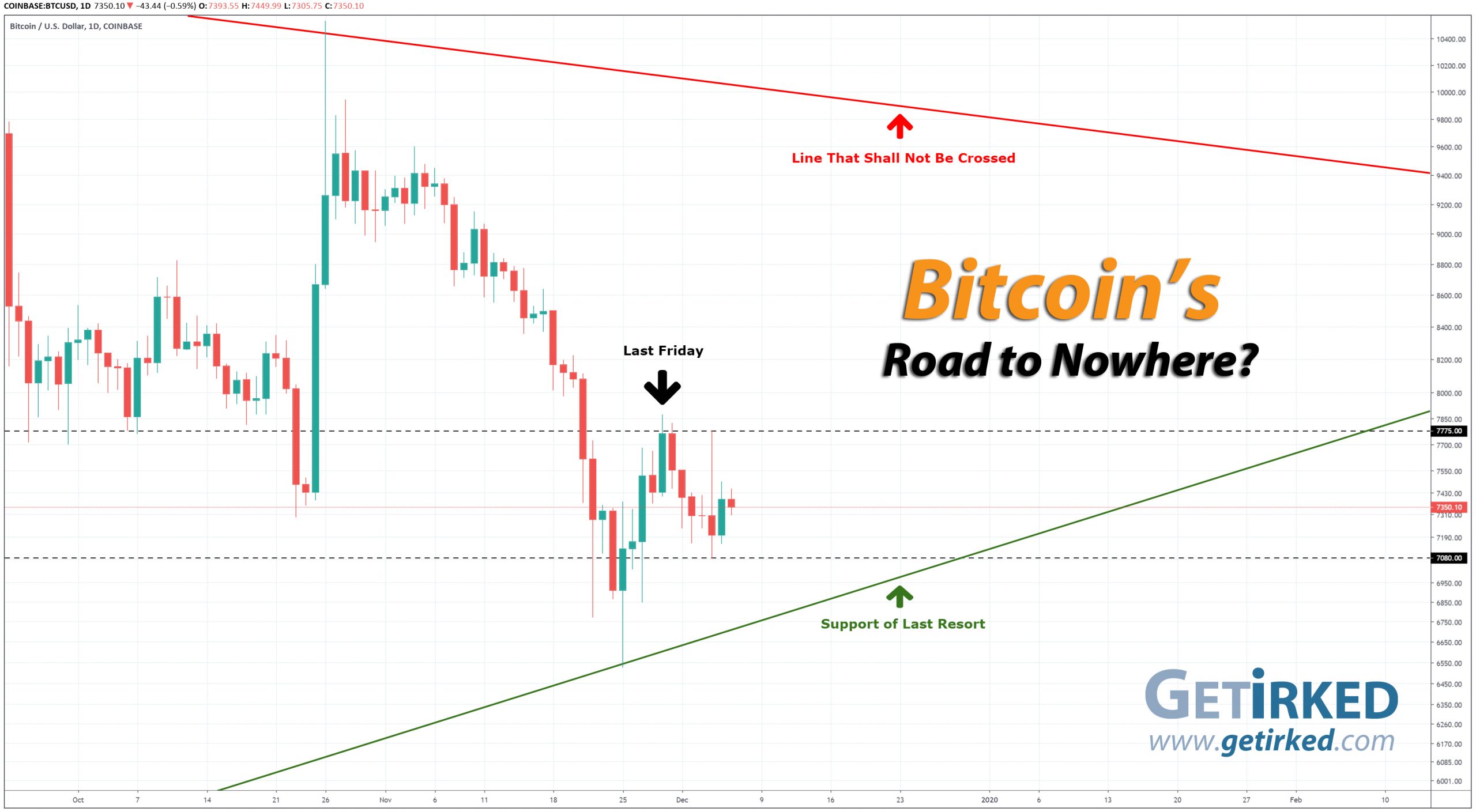Summing Up The Week
For all the analysts who thought the market had priced in all potential Trade War news, President Trump proved them wrong with an off-handed comment made in NATO on Tuesday which sent the indexes reeling.
The market recovered later in the week thanks to alleged reports that the trade deal is still on and very positive jobs numbers released on Friday.
What were the other news stories that moved the markets this week? Read on…
Market News
Manufacturing Activity on the Decline
The Institute for Supply Management (ISM) released their manufacturing data report on Monday, and the news was not goood – PMI dipped down to 48.1 in November, below analyst estimates of 49.4, reported CNBC.
Between the manufacturing weakness, the heightened tensions between the U.S. and China over Hong Kong protesters and the Trade War, and the overbought conditions in the market, Monday saw a swift selloff.
Trump: Let’s Wait Until After 2020 Elections, China…
The market selloff continued in earnest on Tuesday after President Trump said “In some ways, I like the idea of waiting until after election for the China deal” at a NATO summit, reported CNBC.
Trump reinforced his statement in phone calls later saying he has no deadline for the deal. Naturally, he went on to follow through on his previous behavior of criticizing previous U.S. administrations, claiming China had been “ripping off the United States for many, many years” and that a “lack of leadership” allowed it to happen.
Traders and investors fled the markets as the possibility of even a Phase One deal became less and less likely.
Private Payrolls Predominantly Petering
Private payrolls increased by just 67,000 in November as opposed to the consensus estimates of 150,000 according to ADP and Moody’s Analytics, reported CNBC on Wednesday.
“The job market is losing its shine as manufacturers, commodity producers, and retailers are shedding jobs,” said Mark Zandi, chief economist for Moody’s. “The slowdown is more significant than I would have thought, and I do think that goes to the trade war which is doing damage to the economy and the job market.”
Jobs Growth Soared in November
Contrary to the private payroll number from ADP and Moody’s released earlier in the week, Friday’s nonfarm payrolls surged by 266,000 in November compared to just 187,000 expected by economists polled by Dow Jones, reported CNBC.
The Labor Department also reported that the unemployment rate dropped back to 3.5%, the lowest level of unemployment since 1969. The end of the General Motors (GM) workers’ strike contributed a significant number to the job report, boosting employment by 54,000 overall.
Average hourly earnings rose by 3.1% from last year, beating the 3% expected.
Sage Therapeutics (SAGE) Dropped -60% in a Day…
… or why I don’t invest in biopharma anymore.
Sage Therapeutics (SAGE) stock imploded on Thursday, dropping $89, or -59.67%, to $60.18 a share in a single trading session after its depression drug unexpectedly failed to meet its key goal at day 15 in a late-stage study, reported Investor’s Business Daily.
Normally, I don’t reference individual stocks in my Week in Review, particularly ones that don’t move the entire market, however SAGE is unique for two reasons: (1) its drop was so significant that it was mentioned during CNBC’s Squawkpod, and (2) I actually owned this stock in the past.
I owned SAGE for slightly over a month from July 13 to August 31, 2018 before deciding its volatility was too much for me to handle, closing the position with a minor +2.26% gain at $163.00, 170.85% higher than where the stock closed Thursday.
SAGE’s epic drop demonstrates why I don’t personally invest in individual biopharmaceutical stocks. While there can certainly be huge gains when a drug succeeds or a company is taken over, the epic drops are just as possible.
The key to long-term investing is to know your own risk appetite.
For some, the potential gains of the biopharma sector far exceed the potential risks. For others, like myself, other sectors may hold less potential growth but provide a more restful night.
Next Week’s Gameplan
As we approach the end of the year, both the Bears and the Bulls are nervous.
The Bulls are concerned about losing any of the year’s epic gains. The Bears are worried that a lack of exposure to the markets will make them appear foolish for missing out on everything the year had to offer.
So, what’s the plan?
The market can only do three things – head higher, head lower, or head sideways. The same as it always has been – I have plans for moves in either direction and sideways will take care of itself.
This Week in Play
Stay tuned for this week’s episodes of my two portfolios Investments in Play and Speculation in Play coming online later this weekend!
Crytpo Corner
Important Disclaimer
Get Irked contributors are not professional advisers. Discussions of positions should not be taken as recommendations to buy or sell. All investments carry risk and all readers must accept their own risks. Get Irked recommends anyone interested in investing or trading any asset class consult with a professional investment adviser to determine if an investment idea is suitable to them and their investment goals.
Bitcoin Price (in USD)
%
Weekly Change
Bitcoin Price Action
Since last Friday, Bitcoin is still experiencing significant volatility. In fact, the weekly high of $7775.00 and weekly low of $7080 were both set just two days ago, on Wednesday, December 4.
For the moment, it would appear that Bitcoin is in a period of price consolidation and will continue to work its way in a range between its $7870.10 high and $6526.00 low.
That being said, anything’s possible and if Bitcoin breaks below the Support of Last Resort and closes there, significantly lower-lows could always be in the cards.
Bitcoin Gameplan
I continue to adjust my gameplan as time moves on. Why? My price levels are based on a combination of moving averages, trendlines, past points of support and resistance, and Fibonacci Retracement analysis. As time passes, the correlation of support and resistance adjusts, too.
I made no additional moves over the past week, so I currently hold 5.99% of my desired allocation with a per-coin cost of $8,199.77.
Here are my quantities and buying levels from this point:
0.55% @ $6312
4.68% @ $5287
5.32% @ $4675
12.48% @ $3815
8.40% @ $3546
14.71% @ $3206
11.86% @ $2537
14.29% @ $2187
15.50% @ $1788
6.22% @ $1118
Why the differing quantities at each level instead of a flat percentage?
Rather than buying an equal percentage, I change my buying quantity at each stage as a reflection of how possible I feel it is that Bitcoin could bottom and rebound from each point. The more Bitcoin pulls back, the more likely a rebound becomes. Therefore, higher price points have a lesser likelihood of rebounding than lower price points and deserve a smaller quantity buy.
No price target is unrealistic in the cryptocurrency space – Bullish or Bearish.
While traditional stock market investors and traders may think the price targets in the cryptocurrency space are outlandish due to the incredible spread (sometimes a drop of near -90% or a gain of up to +1000% or more), Bitcoin has demonstrated that, more than any speculative asset, its price is capable of doing anything.
Here are just a few recent price movements over the past couple of years:
- Bitcoin rose 2,707% from its January 2017 low of $734.64 to make an all-time high of $19,891.99 in December of the same year.
- Then, Bitcoin crashed nearly -85% from its high to a December 2018 low of $3128.
- In the first half of 2019, Bitcoin rebounded 343% from $3128.89 to $13,868.44.
- Since June 2019, Bitcoin has dropped -52.94% to a low of $6526.
Where will Bitcoin go from here? Truly, anything is possible.
What if Bitcoin’s headed to zero?
The only reason I speculate in the cryptocurrency space is I truly believe Bitcoin isn’t headed to zero. I am prepared for that possibility, however, by knowing I could potentially lose all of the capital I’ve allocated to this speculative investment. Professional advisers recommend speculating with no more than 5% of an investor’s overall assets. Personally, I’ve allocated about 1.8% of my assets to speculating in crypto.
I feel that anyone who doesn’t believe in the long-term viability of cryptocurrency would be better served not speculating in the space. On a good day, this asset class isn’t suitable for those with weak stomachs. On volatile days, the sector can induce nausea in the most iron-willed speculator.
DISCLAIMER: Anyone considering speculating in the crypto sector should only do so with funds they are prepared to lose completely. All interested individuals should consult a professional financial adviser to see if speculation is right for them. No Get Irked contributor is a financial professional of any kind.
Get Irked in your Email?
We’re making a list and checking it twice! If there’s enough interest, we’ll start sending the Week in Review straight to your inbox!
Interested? Click here to sign up!


